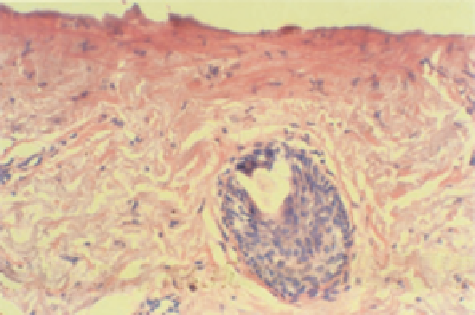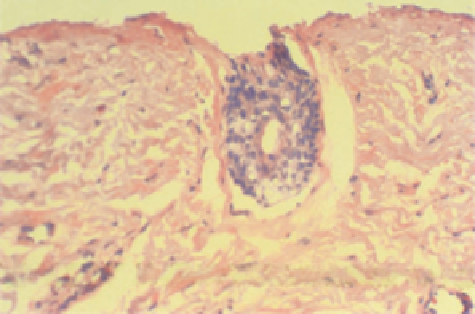Biomedical Engineering Reference
In-Depth Information
(
A
)
(
B
)
Figure 6.45
(
A
) Two passes of CO
2
laser at 7 J/cm
2
leaves approximately 70
μ
m of residual thermal necrosis. (
B
) Two passes of erbium laser at 10 J/cm
2
result in
removal of approximately 50
μ
m of this necrotic tissue, resulting in faster wound healing.
Combined laser resurfacing with
the UPCO
2
+ Er:YAG lasers:
Thermal damage and new collagen
2a. The CO
2
laser may be used with either the 3-mm
spot or the CPG in small areas that will benefi t
from collagen tightening, such as the lower eye-
lids or medial cheeks and areas of atrophic acne
scarring.
2b. The Er:YAG laser may be used uniformly in one or
two passes to remove superfi cial photodamage and
fi ne wrinkles and to feather the periphery.
3.5
3
2.5
Er damage
CO
2
damage
Er collagen
CO
2
collagen
2
1.5
Significant Photodamage and Scars
When treating patients who desire the maximal improvement
in a single treatment and who have signifi cant photodamage or
acne scarring, the laser surgeon performs the following steps:
1
0.5
0
Immed
2-3 days
1 week
4-8 weeks
1. The epidermis is removed with a single pass of the
CO
2
laser, usually with a density overlap of 30%.
2. A second pass of the CO
2
laser is done uniformly
across the entire face, usually with a density overlap
of 20-30%.
3. A third pass of the CO
2
laser is done in areas still
having visible photodamage or scarring, generally
the glabella and nose, middle lower forehead, middle-
to-lateral cheeks and upper lip, and lateral chin ar-
eas, usually with a density overlap of 20-30%.
4. The 3-mm spot of the CO
2
laser is used to vapor-
ize or induce thermal necrosis in areas of distinct
photodamage or selectively to tighten loose photo-
damaged tissue, such as the eyelids, lateral cheeks,
and atrophic scars. When used to induce thermal
necrosis, the handpiece is moved slowly across the
shoulder of a deep wrinkle line, the sharp edges of
a scar crater, along the elevated portions of a lin-
ear scar, or over any dermal or epidermal growth,
such as rhinophyma, syringoma, or seborrheic kera-
tosis. The intent is to cause some superfi cial brown-
ish char that will subsequently be ablated with the
erbium laser.
5. The Er:YAG laser is used in a uniform manner, as in
step 2b for early photodamage, removing the super-
fi cial portion of the 50-70
(
A
)
Combined laser resurfacing with
the UPCO
2
+ Er:YAG lasers:
Inflammation and angiogenesis
1.8
1.6
1.4
1.2
Inflam Er
Inflam CO
2
Angio Er
Angio CO
2
1
0.8
0.6
0.4
0.2
0
2-3 days
1 week
4-8 weeks
(
B
)
Figure 6.46
(
A
) Initial thermal necrosis was shown to be reduced signifi cantly
by adding erbium laser passes after the use of ultrapulsed CO
2
(UP CO
2
) laser,
without compromising new collagen formation at 4-8 weeks. (
B
) Infl amma-
tion was greatly reduced at 1 week postoperatively by removing thermal
necrosis with erbium laser. Angiogenesis was also reduced at 1-8 weeks com-
pared with the use of UP CO
2
laser alone.
If only epidermal removal is desirable, treatment is
completed by using the Er:YAG laser to clean up any
epidermal remnants and to feather the periphery.
If dermal treatment of acne scars or photodamage
is required, the areas of treatment are assessed with
consideration of step 2.
m of residual thermal
damage left by the CO
2
laser, thereby enhancing the
reepithelialization process. This requires two passes
at 1.7 J and a 4-mm pulse.
μ






































































